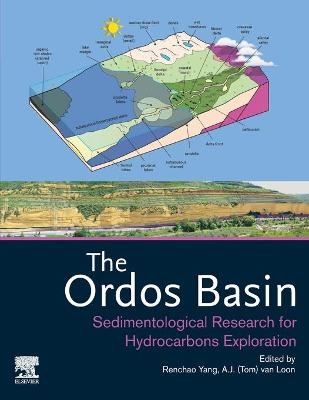
The Ordos Basin
Elsevier - Health Sciences Division (Verlag)
978-0-323-85264-7 (ISBN)
Dr. Renchao Yang is a professor at the Laboratory for Marine Mineral Resources, Qingdao National Laboratory for Marine Science and Technology and at the Shandong Provincial Key Laboratory of Depositional Mineralization & Sedimentary Mineral of Shandong University of Science and Technology. He studied sedimentology and petroleum geology. He focuses on tight sandstone reservoirs, gravity-flow deposits and soft-sediment deformation structures of the Triassic Yanchang Formation, and on the Permian Sulige Gas Field in the Ordos Basin now for 20 years. He received 20 research grants in this field and published some 90 articles, both in English and in Chinese. Two of them (published in AAPG Bulletin, 2017, and in the Journal of Geodynamics, 2019) are highly cited. A.J. (Tom) van Loon studied geology in Leiden (Netherlands), where he received his Ph.D. in 1972 for a thesis on the sedimentological development of a Carboniferous intramontaneous basin in Spain. He held various positions in academia and industry, and was a professor of Geology at the University of Silesia (Katowice, Poland) and the Adam Mickiewicz University (Poznan, Poland), and is currently visiting professor at the Shandong University of Science and Technology (Qingdao, China). His main interests are soft-sediment deformation, basin analysis and mass flows. Currently he is involved in the sedimentological analysis of hydrocarbon occurrences in China. He authored, co-authored and edited several books and around 200 scientific publications. He held numerous editorial positions. He is an Honorary Member of the Geological and Mining Society of The Netherlands.
1. Sedimentary and tectonic development of the Ordos Basin and its hydrocarbon potential
Section A Relationships between tectonics, sedimentology, diagenesis, and hydrocarbon reservoirs 2. The collision between the North China Block and the South China Block, and the resulting event beds in the Triassic Yanchang Formation (southern Ordos Basin, China) 3. Origin and evolution of dolomite reservoirs in the Ordovician Majiagou Formation, Central and Eastern Ordos Basin, NW China 4. Depositional model and diagenetic evolution of hydrocarbon reservoirs in deep dolomites of the Ordos Basin, China 5. Facies shifts in the Ordos Basin (China) along the southern and western margins of the North China Plate as a result of plate tectonics 6. Evolution during the Permian from a marine to a continental setting, south-eastern Ordos Basin, China 7. Hydrocarbon accumulations in the Permian Shanxi Formation (Ordos Basin, China) as controlled by sedimentary heterogeneities 8. Subsidence of the Mesozoic Ordos Basin and resulting migration of depocenters
Section B The role of diagenesis in gas fields 9. Chlorite coatings of quartz grains and the implications for Permian gas reservoirs in the Ordos Basin (China) 10. Gas geochemistry indicates Ordovician marine micrites as the main source rock of natural gas in a weathered limestone reservoir (Jingbian Gas Field, Ordos Basin, China) 11. The influence of diagenesis on low-porosity, low-permeability gas reservoirs in the Sulige Gas Field (Ordos Basin, China) 12. Diagenetically induced heterogeneity of tight gas reservoirs near Zizhou (Ordos Basin, eastern China)
Section C Understanding facies problems 13. Facies distribution in the Ordovician Pingliang Formation (southern Ordos Basin, China) and the role of turbidity currents 14. When turbidity currents cross contour currents: a struggle for life in the Ordovician along the southern margin of the Ordos Basin (China) 15. Predicting the spatial distribution of sandy mass-flow deposits in deep basins by analysis of mud-coated structures
Section D Focus on the Yanchang Formation 16. Lacustrine sequence stratigraphy: New insights from the study of the Yanchang Formation (Middle-Late Triassic), Ordos Basin, China 17. The origin of hyperpycnites in the Middle-Late Triassic Yanchang Fm. (Ordos Basin, China) and their significance for the formation of unconventional hydrocarbons 18. Influence of diagenesis on reservoir properties of the Chang 2 Oil Member of the Yanchang Formation in the Zhidan Oil Field (Ordos Basin, China) 19. Slurry deposits in cores from the Middle-Late Triassic Yanchang Formation (Ordos Basin, China) 20. Late Triassic tectono-volcanic activity and resulting soft-sediment deformation structures in the Yanchang Formation (Ordos Basin, China) 21. Middle-Late Triassic muddy gravity-flow deposits in the Ordos Basin (China) 22. Debrite/turbidite transitions in the Chang 6 Oil Member of the Yanchang Formation (Ordos Basin, China) 23. Reservoir quality of the Middle-Late Triassic Yanchang Formation (Ordos Basin) as controlled by sedimentology and diagenesis 24. The significance for unconventional petroleum exploration of a good classification system for gravity-flow deposits, with examples from the Yanchang Formation 25. Quality of tight sandstone reservoirs in gravity-flow deposits of the deep-lacustrine Yanchang Formation (Ordos Basin, China) as controlled by diagenesis
| Erscheinungsdatum | 03.12.2021 |
|---|---|
| Zusatzinfo | Approx. 150 illustrations; Illustrations |
| Verlagsort | Philadelphia |
| Sprache | englisch |
| Maße | 216 x 276 mm |
| Gewicht | 1430 g |
| Themenwelt | Naturwissenschaften ► Geowissenschaften ► Geologie |
| Technik ► Bergbau | |
| ISBN-10 | 0-323-85264-5 / 0323852645 |
| ISBN-13 | 978-0-323-85264-7 / 9780323852647 |
| Zustand | Neuware |
| Haben Sie eine Frage zum Produkt? |
aus dem Bereich


